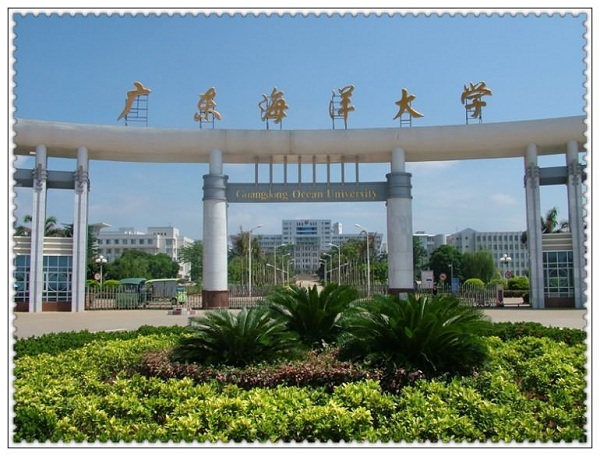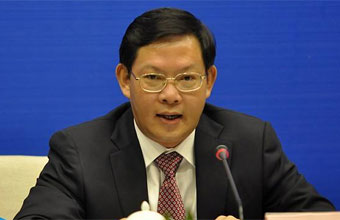Home> Education
Guangdong Ocean University

Guangdong Ocean University. [Photo/gdou.edu.cn]
Guangdong Ocean University is a provincial key university, jointly built by the provincial government and the State Oceanic Administration. It's a comprehensive multi-disciplinary university featuring aquaculture and marine engineering. Its undergraduate education is strong, according to the Ministry of Education. It confers bachelor's, master's and doctorate degrees.
The university is located in Zhanjiang, a beautiful coastal city at the southernmost point of the Chinese mainland, with Huguang, Xiashan and Haibin campuses. The three campuses cover an area of 4,892 mu (3,261,333 square meters), of which the Huguang campus takes up 4,083 mu. The university, surrounded by mountains and facing the ocean, is an ideal place for students.
The university has 19 secondary schools, in the fields of marxism, fisheries, food science and technology, marine science and meteorology, agricultural science, marine engineering, economics, management, software engineering, information technology, chemistry and environment, maritime studies, literature and journalism, law and political science, foreign studies, arts, sports and leisure studies, and continuing education. It also has a teaching department of ideological and political theory, and an affiliated college, Cunjin College.
The university has three first-class disciplines – aquaculture, food science and engineering and marine science – for the doctor's degree, nine first-class and 44 second-class disciplines for the master's degree, as well as 77 undergraduate programs.
There are 2,061 teachers, including 1,464 full-time teachers, 703 people with vice-senior titles or above, 535 doctorate holders, 72 doctoral advisors, 339 postgraduate advisors, six academicians, and two Pearl River Scholar specially-appointed professors.
The university has excellent teaching and scientific research platforms, including a national demonstration center of experimental teaching of fisheries science and technology, a national research and development center of shellfish processing technology (Zhanjiang), a research center of pearl culture and processing engineering technology, a provincial key lab for pathogeny biology and epidemiology of aquatic economic animals, a provincial key lab for aquatic product processing and security, a provincial key lab for marine changes and disaster warnings, a provincial ocean development and research center, a study base of Leizhou culture, a provincial center for assessment and consultancy of local legislation, a research center of the marine culture industry (co-built by the Center and the State Oceanic Administration), and a provincial study base for humanities and social sciences – the research center of marine economy and management.
The university is well equipped with teaching facilities, including teaching buildings, science buildings, a library, a gym, a museum, student apartments, canteens, as well as featuring an ocean plaza, a culture plaza, a playground and a standard swimming pool.
The overall floorage of school buildings is 803,700 square meters. The library comprises about 3.56 million volumes (including e-books). The equipment for teaching and scientific research is worth 518 million yuan ($73.63 million), and its fixed asset value reaches 2.07 billion yuan. In addition, an extensive and convenient campus network has been constructed.
The university has made great achievements in cultivating talented people. In the past 84 years, 200,000 students received education here, including Chen Hongze, New China's first ocean-going captain; Zhong Lin, founder of artificial breeding of the four major types of Chinese carp; Xie Shaohe, a pearl magnate; and Wen Guohui, mayor of Guangzhou.
The university has made great strides in scientific research, and its social service capacity has been strengthened. It has undertaken 2,425 scientific research projects of the national "973" and "863" programs, national sci-tech support plan, Natural Sciences Foundation of China and National Social Science Fund, of which 286 are national projects. Its scientific research fund has reached 740 million yuan. The university has won 29 various science and technology awards at or above the provincial and ministerial level.
The university has carried out exchanges and cooperation with more than 50 institutes of higher learning and research organs from the US, Japan, the UK, Australia, and China's Hong Kong and Taiwan. It has also conducted cooperation in talent cultivation and scientific research with many enterprises and public institutions, government sectors and military units.

 Print
Print Mail
Mail 5G construction supports Zhanjiang's high-quality development
5G construction supports Zhanjiang's high-quality development
 Acting mayor inspects project construction in Xuwen, Leizhou
Acting mayor inspects project construction in Xuwen, Leizhou Zhanjiang island an "egret paradise"
Zhanjiang island an "egret paradise"  Dancing egrets add vitality to Xiashan
Dancing egrets add vitality to Xiashan